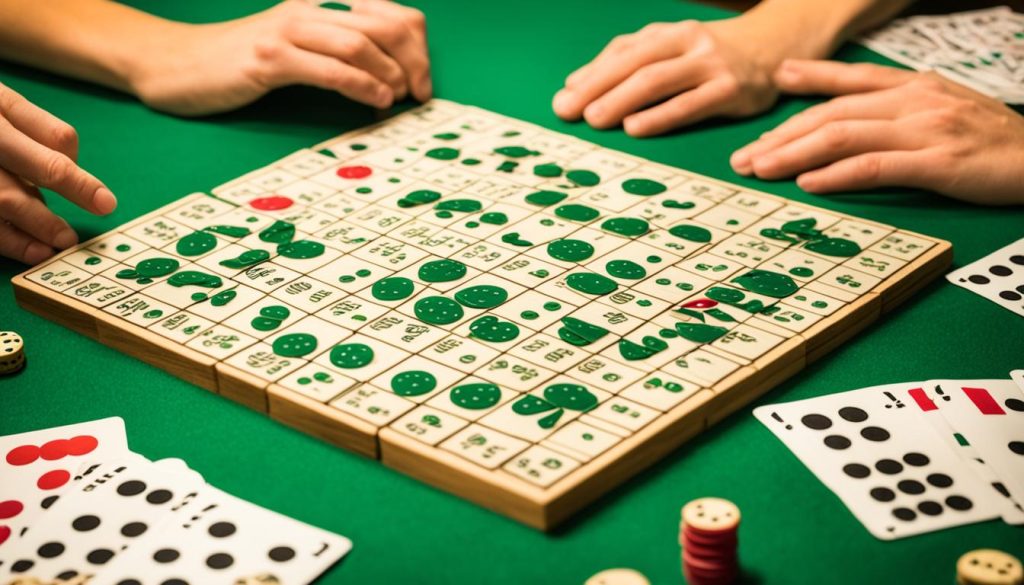Mexican dominoes is a classic tile-based game that originated in Mexico. It is played with a double-12 domino set and can accommodate 2-8 players. The objective is to be the first player to lay down all their dominoes and score the lowest points. The game involves creating personal trains, as well as a shared “Mexican Train” that any player can contribute to. It requires strategy, tile management, and adaptation to your opponents’ moves. This beginner’s guide will provide a comprehensive overview of the rules, gameplay, and tips to help you master Mexican dominoes.
Introduction to Mexican Dominoes
Mexican dominoes, also known as “Mexican Train Dominoes,” is a variant of the classic domino game. It is a tile-based game that incorporates elements of strategy, social interaction, and friendly competition. The game is played with a double-12 domino set, which consists of 91 tiles ranging from double-0 to double-12. Each tile displays a specific number of pips (dots) on both ends, with double tiles having the same number of pips on both ends.
What is Mexican Dominoes?
Mexican dominoes is a popular tile-based game that combines elements of strategy, social interaction, and friendly competition. The game is played with a double-12 domino set, featuring 91 tiles ranging from double-0 to double-12, each displaying a specific number of pips (dots) on both ends.
Brief History of the Game
The origins of Mexican dominoes can be traced back to the early 20th century in Mexico. The game is believed to have evolved from the traditional European domino variants, adapting and incorporating unique rules and mechanics that reflect the Mexican culture and gameplay preferences. Over time, Mexican dominoes has gained popularity worldwide, becoming a beloved family and social game enjoyed by players of all ages and skill levels.

How to Play Mexican Dominoes?
Equipment Needed
To play Mexican dominoes, you will need the following equipment:
- A double-12 domino set, consisting of 91 tiles
- Markers or tokens to designate each player’s train, such as coins or small objects
- A flat surface, such as a table or large board, to accommodate the game
Setup and Distribution of Tiles
To set up the game, the dominoes are shuffled and placed face-down on the playing surface, creating the “boneyard.” The number of dominoes each player draws depends on the number of players:
- 2-4 players: Each player draws 15 dominoes
- 5-6 players: Each player draws 12 dominoes
- 7-8 players: Each player draws 11 dominoes
Players then stand their dominoes on edge, facing themselves, to keep their tiles hidden from their opponents.
Starting the Game
The player with the highest-value double tile (e.g., double-12) starts the game by placing that tile in the centre of the playing area, creating the “engine” of the Mexican Train. If no player has a double tile, the game starts with the player who draws the highest-value tile placing it in the centre.
Playing Dominoes and Scoring
On each turn, a player must match the value of the open end of the Mexican Train or their own personal train by playing a tile with a matching number of pips. If a player cannot match the open end, they must draw a tile from the boneyard. If they can play the drawn tile, they do so; otherwise, they place a marker on their own train to indicate it is “open” for other players to contribute to.
The game continues until one player runs out of dominoes, at which point the remaining players add up the pips on their remaining tiles to determine their scores. The player with the lowest total score after three rounds is the winner.

Strategies and Tips
Doubles are an integral component of Mexican dominoes, as they grant the player an additional turn. However, effectively managing these valuable tiles is crucial. Skilled players should aim to swiftly close out their doubles by playing another tile on them, as an open double tile must be played before any other moves can be made.
Managing Doubles Wisely
A key strategy in Mexican dominoes is to capitalise on the advantages offered by double tiles. Players must be strategic in the timing and placement of their doubles, maximising the benefits while minimising the risks. Closing out doubles expeditiously can create openings for further plays and disrupt opponents’ plans.
Controlling the Pace
Pacing is an important strategic consideration in Mexican dominoes. By carefully timing the placement of their tiles and the opening or closing of their personal trains, players can establish a rhythm and seize opportunities to capitalise on their opponents’ moves. Controlling the tempo of the game can give players the upper hand and allow them to dictate the flow of play.
Reading Your Opponents
Observing and anticipating your opponents’ plays is a valuable skill in Mexican dominoes. Paying close attention to the tiles they discard, the trains they open or close, and the patterns they establish can provide valuable insights. This information can inform your own decision-making, helping you make informed moves and prepare for potential threats or openings.

Variations of Mexican Dominoes
While the classic version of Mexican dominoes provides an engaging and strategic gaming experience, the game has inspired several captivating variations that offer unique twists and challenges. Let’s explore some of the most popular Mexican dominoes variations.
Single Track Variation
The Single Track variation of mexican dominoes simplifies the game by having a single, shared train instead of individual private trains. Players take turns contributing tiles to the central train, and the first player to empty their hand wins the round. This variation emphasizes tile placement and strategic decision-making, as players must carefully consider how their moves impact the shared track.
Draw Game Variation
In the draw game mexican dominoes variation, players draw tiles from the boneyard until one player can legally play a tile. This variation places a greater emphasis on tile management and the ability to adapt to the available options, rather than relying on establishing personal trains. The draw game encourages players to keep a keen eye on the remaining tiles and make informed decisions about when to play or hold onto their dominoes.
Mexican Standoff Variation
The mexican standoff mexican dominoes variation introduces a more competitive element to the game. When a player is unable to play a tile, they must draw a tile from the boneyard and place it on an opponent’s train, creating a standoff situation. This can lead to a tense and strategic battle, as players try to manoeuvre their way out of the standoff while also preventing their opponents from doing the same. The Mexican Standoff variation adds an extra layer of challenge and interaction to the game.
Advanced Techniques
Mastering the use of double tiles is a hallmark of advanced Mexican dominoes play. Skilled players strategically time the placement of their doubles to disrupt their opponents’ plans, create scoring opportunities, or extend their own turns. This strategic doubling in Mexican dominoes is a key skill for professional Mexican domino players to develop.
Endgame Mastery
The endgame of Mexican dominoes requires careful tile management and anticipation of your opponents’ moves. Experienced players develop the ability to efficiently play off their remaining tiles, close out their trains, and block their opponents’ paths to victory. This endgame mastery in mexican dominoes is essential for how to win at mexican dominoes.
Risk Management
Successful Mexican dominoes players assess and manage risks throughout the game. This includes deciding when to open their trains, when to challenge their opponents, and when to play conservatively to maintain their competitive position. Effective risk management in mexican dominoes is crucial for how to play mexican dominoes with 4 players or how to play mexican dominoes with 2 players.

Customising the Game
Mexican dominoes allows for customisation of the scoring rules to suit the preferences of the players. Some common variations include altering the point values of certain tiles, adjusting the scoring system for the final round, or introducing bonus points for specific achievements.
Adjusting Scoring Rules
While the standard Mexican dominoes scoring system awards points based on the total pips on a player’s remaining tiles, creative adjustments can add an extra layer of strategy to the game. For instance, players may decide to assign higher point values to certain tiles, such as doubles or tiles with specific numbers. Alternatively, the scoring for the final round could be modified, rewarding players who are able to empty their hands first.
Modifying Setup and Distribution
The setup and tile distribution of Mexican dominoes can also be modified to change the dynamics of the game. For example, players may decide to use a different domino set (e.g., double-15), adjust the number of tiles each player draws, or experiment with alternative tile placement methods. These adjustments can introduce new challenges and force players to adapt their strategies accordingly.
Creating Hybrid Variations
Building upon the core mechanics of Mexican dominoes, players can create hybrid variations by combining elements from other domino games or introducing entirely new rules and gameplay features. This allows for endless possibilities to customise the experience and keep the game fresh and engaging. Whether it’s incorporating scoring mechanisms from other domino variants or developing unique tile-laying patterns, the opportunities to innovate are endless.

Conclusion
Mexican dominoes is a captivating and versatile game that can be enjoyed by players of all skill levels. Whether you’re a beginner looking to learn the step-by-step basics of how to play dominoes or an experienced player seeking to master the intricacies of the Mexican train dominoes variation, this classic tile-based game offers endless opportunities for fun, social interaction, and strategic gameplay.
By understanding the fundamental rules, implementing effective techniques such as managing doubles and reading your opponents, and exploring the various gameplay variations, you can unlock the full potential of Mexican dominoes. The game’s adaptability allows you to customise the scoring, setup, and distribution to suit your preferences, ensuring a fresh and engaging experience every time you play.
Whilst Mexican train dominoes may present some initial challenges, its depth and versatility make it a highly rewarding game to master. With patience, practice, and a willingness to experiment, you’ll find that the satisfaction of outmaneuvering your opponents and emerging victorious is well worth the effort. So, gather your friends, family, or fellow dominoes enthusiasts, and embark on an unforgettable journey through the captivating world of Mexican dominoes.






